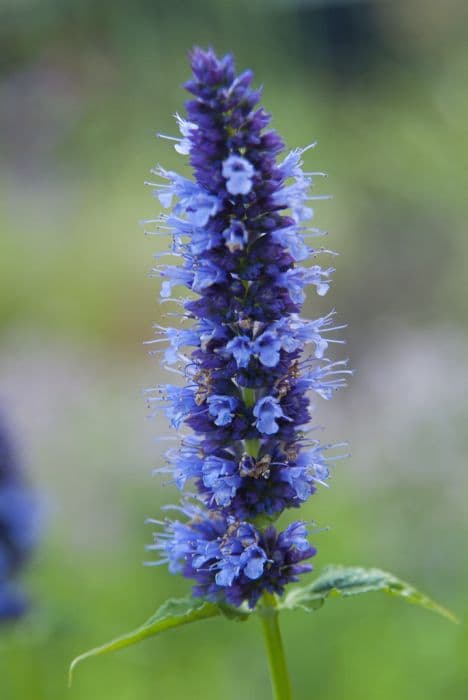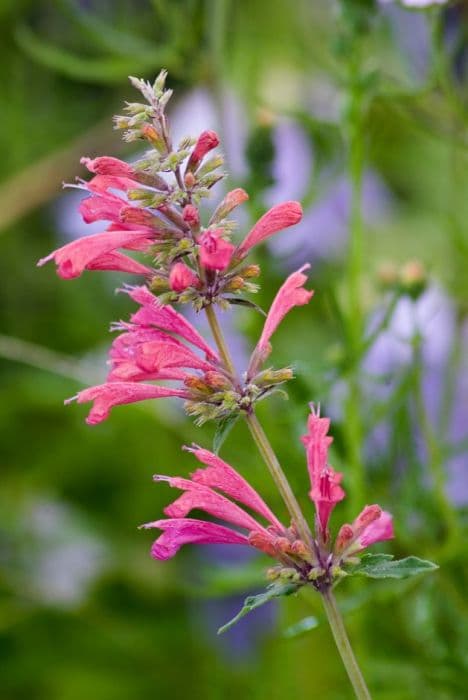Broad-leaved Thyme Thymus pulegioides 'Bertram Anderson'

ABOUT
Thymus pulegioides 'Bertram Anderson', commonly known as lemon thyme, is a small, fragrant perennial herb characterized by its mat-forming growth habit. Its appearance is marked by tiny, rounded leaves that are a bright, glossy green, sometimes edged with a hint of cream or gold, which makes it particularly attractive in garden settings. These leaves are not only aesthetically pleasing but also release a delightful lemony scent when bruised or crushed, adding a sensory dimension to its appeal. The plant produces clusters of small flowers that usually bloom in shades of pink or light purple, creating a delicate contrast against the green foliage. These blossoms are a favorite among bees and other pollinators, contributing to the ecological value of the plant. The overall impression of lemon thyme is one of lush, low-growing greenery, which can be used to adorn rock gardens, borders, and as a culinary herb.
About this plant
 Names
NamesSynonyms
Broad-leaved Thyme, Lemon Thyme
Common names
Thymus pulegioides 'Bertram Anderson'.
 Toxicity
ToxicityTo humans
The plant commonly known as lemon thyme is not considered toxic to humans. In fact, it is often used as a herb in cooking and traditional medicine. However, ingestion in excessive quantities could potentially cause digestive discomfort, such as nausea or stomach upset, due to its strong oils and compounds. Individuals with allergies to plants in the Lamiaceae family should exercise caution, as they may experience allergic reactions.
To pets
Lemon thyme is not known to be toxic to pets. It is considered safe for dogs and cats, and is often used as a non-toxic landscape choice for pet owners. However, as with any plant, ingestion in large amounts could cause gastrointestinal upset or distress, so it is advisable to monitor your pet's interaction with the plant and ensure they do not consume it excessively.
 Characteristics
CharacteristicsLife cycle
Perennials
Foliage type
Evergreen
Color of leaves
Green
Flower color
Pink
Height
6 inches (15 cm)
Spread
12 inches (30 cm)
Plant type
Herb
Hardiness zones
5
Native area
Europe
Benefits
 General Benefits
General Benefits- Culinary Uses: Thyme is a versatile herb used in various cuisines to flavor meats, soups, and stews.
- Garden Aesthetic: Bertram Anderson thyme adds ornamental value with its small leaves and pinkish-purple flowers, suitable for rock gardens, borders, or as ground cover.
- Aroma: The plant emits a pleasant, distinctive herbal scent when its leaves are brushed or crushed.
- Attracts Pollinators: Its flowers are attractive to bees, butterflies, and other beneficial insects.
- Drought Tolerance: Once established, thyme is quite drought-resistant, making it a good choice for xeriscaping or low-water gardens.
- Easy to Grow: With minimal care, this plant can thrive and is relatively easy for beginners to cultivate.
- Culinary Versatility: The leaves can be used fresh or dried, and either way, they retain their flavor, enhancing the versatility of this culinary herb.
- Low Maintenance: Thyme has minimal fertilization and pruning requirements, making it quite easy to maintain over time.
- Soil Erosion Control: Its mat-forming growth habit helps stabilize soil, preventing erosion on slopes.
- Herb Garden Essential: A staple in any herb garden, offering both practical uses and aesthetic appeal.
- Companion Planting: Can be beneficial when planted with other herbs or vegetables, potentially enhancing growth and flavor.
 Medical Properties
Medical Properties- Antiseptic - Thymus pulegioides is known to have antiseptic properties, which means it can inhibit the growth of microorganisms.
- Antimicrobial - The plant possesses antimicrobial effects, aiding in the inhibition of bacteria and fungi.
- Carminative - It may relieve flatulence, aiding in the reduction of bloating and digestive discomfort.
- Expectorant - Thymus pulegioides can act as an expectorant, helping to clear mucus from the airways.
- Spasmolytic - The plant has been known to help reduce spasms in the muscles.
 Air-purifying Qualities
Air-purifying QualitiesThis plant is not specifically known for air purifying qualities.
 Other Uses
Other Uses- Thymus pulegioides, commonly known as large thyme, can be used as a natural dye source, providing a range of colors from greens to browns depending on the mordant used.
- A companion plant in the garden, large thyme can attract beneficial insects like bees and butterflies which are important for pollination of nearby plants.
- The plant's low-growing, mat-forming habit makes it an excellent ground cover that can help control soil erosion in sloped areas.
- Large thyme can be planted between paving stones or in a rock garden, where it will release its fragrance when trodden upon.
- The dried leaves and flowers of large thyme can be used as a fragrant filling for herbal pillows or sachets, providing a pleasant aroma and potentially aiding in better sleep.
- It can serve as a natural insect repellent; planting it around patios or seating areas may help deter mosquitoes and other pests.
- Large thyme is sometimes incorporated into landscaping for xeriscaping, due to its drought resistance, making it suitable for water-efficient gardens.
- Its aesthetic appeal when flowering can be leveraged for ornamental purposes in container gardening, adding both foliage texture and blooms.
- Large thyme can be used in the creation of living furniture, such as growing it over a frame to form a natural seat or decorative piece.
- The essential oils from the plant can be used in homemade natural cleaning products to add fragrance and potential antimicrobial properties.
Interesting Facts
 Feng Shui
Feng ShuiThe Thyme is not used in Feng Shui practice.
 Zodiac Sign Compitability
Zodiac Sign CompitabilityThe Thyme is not used in astrology practice.
 Plant Symbolism
Plant Symbolism- Strength and Courage: Thymus pulegioides, commonly referred to as 'Lemon Thyme', is traditionally associated with strength and courage. In ancient times, it was believed that the plant could impart bravery to warriors going into battle.
- Healing and Restoration: Due to its medicinal properties, Lemon Thyme symbolizes healing and the restoration of health.
- Cleansing: Lemon Thyme carries the symbolic meaning of cleansing, both in a physical sense, in terms of its antiseptic qualities, and in a spiritual sense, as it's thought to purify and promote a positive environment.
- Affection: In the language of flowers, Lemon Thyme can represent affection, as it's said that giving the herb means the person holds a significant place in the giver’s heart.
- Longevity and Eternal Life: Lemon Thyme is also a symbol for longevity and eternal life, perhaps due to its evergreen nature and enduring fragrance.
 Water
WaterThe Broad-leaved Thyme should be watered deeply but infrequently to mimic its preferred Mediterranean conditions, allowing the soil to dry out slightly between waterings. Typically, watering every 7 to 10 days during active growing seasons in spring and summer is sufficient. Reduce the frequency in fall and winter, aiming for every 10 to 14 days, depending on ambient temperature and humidity. When watering, provide enough water to saturate the root zone; for potted plants, this usually means until water runs freely from the drainage holes, which could be around 16 to 32 onzes for smaller pots.
 Light
LightBroad-leaved Thyme thrives best in full sun conditions, meaning it should receive at least 6 to 8 hours of direct sunlight per day. The ideal spot for this herb is in a south-facing garden where it can benefit from the most intense sunlight, facilitating healthy growth and essential oil production in the leaves.
 Temperature
TemperatureBroad-leaved Thyme prefers warm temperatures and does well in a range between 60 to 80°F. It can survive minimum temperatures down to 10°F but growth will be significantly hindered below 50°F. The plant enjoys the warmth and has an ideal temperature range of 70 to 75°F for optimal growth.
 Pruning
PruningBroad-leaved Thyme should be pruned to encourage fuller growth and to prevent the plant from becoming leggy. Prune lightly after the plant has flowered, typically in late spring or early summer. This will also help to maintain the desired shape and size of the plant. It's unnecessary to prune more than once a year unless the plant is being harvested regularly for culinary use.
 Cleaning
CleaningAs needed
 Soil
SoilThe best soil mix for Lemon Thyme, commonly known as Thymus pulegioides 'Bertram Anderson', is well-draining and sandy with some organic matter. A pH range that is neutral to slightly alkaline, between 6.0 and 8.0, is ideal for its growth.
 Repotting
RepottingLemon Thyme should be repotted every 2-3 years or when it outgrows its current container. This helps to replenish the soil and provide room for growth.
 Humidity & Misting
Humidity & MistingLemon Thyme thrives in moderate humidity levels but is quite adaptable and tolerates lower humidity well. Extremely high humidity should be avoided as this can encourage fungal diseases.
 Suitable locations
Suitable locationsIndoor
Use well-draining soil, place in a bright spot.
Outdoor
Full sun, well-drained soil, water when dry.
Hardiness zone
5-9 USDA
 Life cycle
Life cycleThymus pulegioides 'Bertram Anderson', commonly known as lemon thyme, begins its life as a seed, which requires well-drained soil and light for successful germination. The seedling stage follows, where its roots and foliage start to develop; this stage requires adequate sunlight and well-drained soil to establish a healthy plant. As it enters the vegetative stage, the plant grows and produces a dense mat of foliage, characterized by its fragrant leaves and sturdy stems which are used for culinary and ornamental purposes. Lemon thyme then reaches the flowering stage, where it produces small, usually purple or pink flowers that are attractive to pollinators like bees during late spring to early summer. The plant is a perennial herb, which means it can live for several years, going dormant in the winter and resuming growth in the spring. Throughout its life, the plant continues to spread and can be propagated through division or cuttings to produce new plants.
 Propogation
PropogationPropogation time
Spring to early summer
Thymus pulegioides 'Bertram Anderson', commonly known as lemon thyme, is typically propagated through stem cuttings. This is often done in the spring or early summer, when the plant's growth is most vigorous. To propagate through stem cuttings, a 4 to 6 inch (10 to 15 cm) portion of the stem is cut from a healthy plant. The lower leaves are removed, and the cut end is dipped in rooting hormone to encourage root growth. The stem is then placed in a well-draining soil mix and kept moist under a humidity dome or plastic wrap to retain moisture. It usually takes several weeks for roots to develop, after which the new plant can be gradually acclimatized to less humid conditions before being transplanted to its final location.





![Bugle [Sugar Plum]](/_next/image?url=https%3A%2F%2Fplants-admin.emdemapps.com%2Fimages%2Fplants%2F%2Fimages%2F604b597956a55.png&w=640&q=75)
![Bugle [Princess Nadia]](/_next/image?url=https%3A%2F%2Fplants-admin.emdemapps.com%2Fimages%2Fplants%2F%2Fimages%2F604b5806e268c.png&w=640&q=75)


